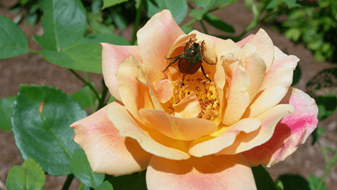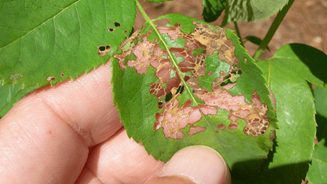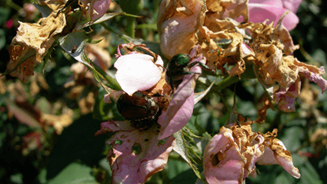As the summer heat arrives, we take special care to maintain our trees. This way, they’ll hold on to their full canopy and radiant, seasonal glow all summer.

Unfortunately, there’s one summer pest that gives our trees just as much attention, but doesn’t treat them as kindly: japanese beetles.
These insects, currently distributed in most US states east of the Rocky Mountains, invade tree canopies on warm, sunny days. You can control their damage, though, if you take quick action. Below, discover what trees Japanese beetles do and don’t prefer to attack and how to control it.
When do Japanese beetles arrive?
This pest emerges and attacks plants from mid-June to August.
What trees do Japanese beetles eat?
This pest has been found to feed on over 300 plant species, but it does play favorites. Here are a few tree species that Japanese beetles love:
- Crape myrtle
- Birch
- Littleleaf linden
- Crabapple
- Purple leaf plum
- Japanese maple
- Norway maple
- Weeping cherry
- Ornamental cherry
Are there Japanese beetle resistant trees?
Yes! There are a few trees Japanese beetles tend to avoid:
- Evergreens Conifers (pine, fir, spruce, arborvitae)
- Red maple
- White oak
- Red oak
- Redbud
- Rhododendron
How do Japanese beetles do damage to tree leaves?

These flying pests eat tree leaves and flowers. Often, they’ll leave nothing more than the skeleton of foliage behind. Their larvae are also pests of turfgrass because they develop under the soil and feed on grassroots.
When a Japanese beetle infestation is severe, tree leaves may brown at the top of the canopy or leaves may drop prematurely.
How can I get rid of Japanese beetles on trees?

There are many ways to mitigate Japanese beetle infestations. The most important thing is catching beetle activity early and deploying management strategies properly. The beetles tend to be most active from June to August, so we recommend starting to monitor your landscape in the late spring. A few management methods include:
- Physical removal of beetles in light infestations.
- Putting up barriers (e.g. netting) around smaller plants during peak activity.
- Applying carefully timed chemical or biological insecticides.
Contact your local Davey office for more information about these options and additional recommendations. Please also refer to this USDA website to see if Japanese beetle is in your state and for integrated pest management resources.







